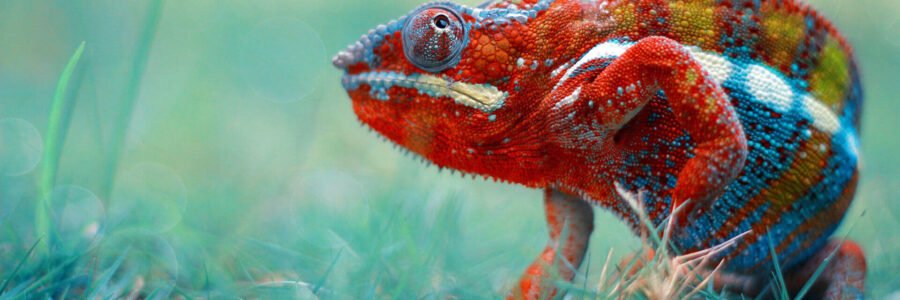Chameleons are fascinating reptiles known for their ability to change color and their unique, independent eye movements. While they make captivating pets, chameleons also require specialized care to thrive. Here are five essential tips for keeping your chameleon happy and healthy.
1. Create the Ideal Habitat
Chameleons need an environment that mimics their natural habitat. Here’s how to set up the perfect enclosure:
- Vertical Space: Choose a tall, well-ventilated terrarium, as chameleons are arboreal and love to climb. A minimum size of 24x24x48 inches is recommended for adult chameleons.
- Live Plants: Include live plants like Ficus, Pothos, or Hibiscus to provide perches and hiding spots. These plants also help maintain humidity levels and create a naturalistic environment.
- Basking Spots and UVB Lighting: Ensure there are branches at different heights and a basking spot where your chameleon can absorb heat. A UVB bulb is essential for calcium absorption and preventing metabolic bone disease.
2. Maintain Proper Temperature and Humidity Levels
Chameleons are sensitive to temperature and humidity fluctuations, so it’s crucial to maintain the right conditions:
- Temperature: Provide a basking spot with a temperature of 85-95°F (29-35°C) and keep the rest of the enclosure between 70-80°F (21-27°C) during the day. At night, temperatures can drop to around 65-70°F (18-21°C).
- Humidity: Aim for 50-70% humidity, depending on the chameleon species. Use a hygrometer to monitor levels and mist the enclosure several times a day or install an automatic misting system.
- Drip System: Chameleons drink water droplets off leaves, so a drip system or misting the plants is essential to provide hydration.
3. Provide a Balanced Diet
Chameleons are insectivores, so a varied diet of live insects is vital:
- Staple Insects: Offer crickets, roaches, and mealworms as primary food sources. Occasionally, provide hornworms, silkworms, and waxworms as treats for added variety.
- Gut-Loading and Supplements: Gut-load insects with nutritious foods like leafy greens and carrots before feeding them to your chameleon. Dust the insects with calcium powder (without D3) at every feeding and use a multivitamin supplement once a week.
4. Ensure Proper Hydration
Chameleons need access to fresh water, but they don’t usually drink from standing water:
- Misting: Mist the enclosure at least 2-3 times a day to create water droplets on leaves, allowing your chameleon to drink.
- Drip System: A drip system can provide a continuous source of water droplets for hydration. Be sure to clean and refill it regularly to prevent bacteria buildup.
- Hydration Monitoring: Monitor your chameleon’s hydration levels by checking the color of its urates (the white portion of its droppings). A well-hydrated chameleon will have white urates, while yellow or orange urates may indicate dehydration.
5. Regular Health Monitoring and Vet Visits
Chameleons are prone to health issues, so regular observation and vet care are essential:
- Observe Behavior and Appearance: Watch for signs of illness, such as lethargy, lack of appetite, swelling, or abnormal color changes. A healthy chameleon should be active, alert, and exhibit bright colors.
- Check for Shedding Problems: Chameleons shed their skin regularly, and issues like retained shed can indicate low humidity levels. Increase misting if your chameleon has difficulty shedding.
- Routine Vet Visits: Schedule regular check-ups with a reptile veterinarian to monitor your chameleon’s health and catch any potential problems early.
